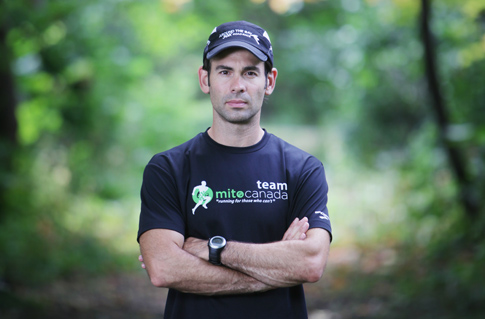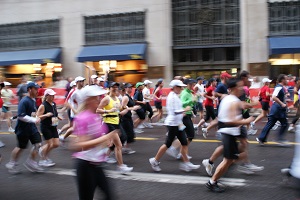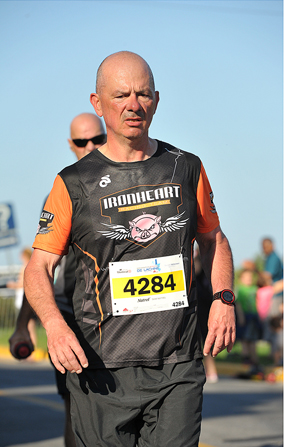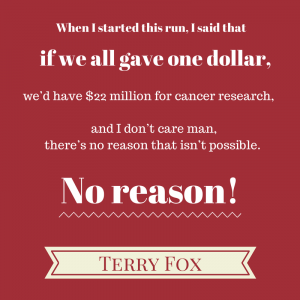 photo by Cole Burston
photo by Cole Burston
iRun to clear my head. Running helps me burn off steam, recharge and refocus. I think it helps make me a better husband, father, colleague and friend.
In the September 2014 issue of iRun, Josh Greenberg — runner, cyclist, family man and a university professor in Ottawa shares part 1 of his journey to break out of a vicious cycle of running injury and finish his next race pain-free. In part 2 of this series, he speaks to the steps it takes—and the ones he’s taken—to get him running injury-free.
The Road to Recovery
By Josh Greenberg
It seems almost everyone in my running network is dealing with one ache and injury or another these days: shin splints, achilles tendinitis, plantar fasciitis, metatarsalgia, ITBS – the list goes on. We’re all juggling families and careers, trying to squeeze in a workout between rushing from a meeting to a kid’s hockey practice or daycare pickup. In my case, this too frequently leads to shortcuts in warm-ups. And forget about stretching to aid in recovery and repair. 90 per cent of the time, I have a small window of opportunity for a run, head out the door, and try to just log as many kilometres as possible.
In the first part of this series I talked about my struggle with chronic injury and pain, and how in the winter of 2010-11, I tore my right calf and achilles during a very sloppy build-up to my first Ottawa Race Weekend Half Marathon. That race wasn’t a total bust: I finished with a limp and walked more than I’d have liked, but my time was respectable, all things considered, and the experience of completing the event was exhilarating. Aside from running longer than I’d ever run before, I was drawn in by the atmosphere of the race, both on and off the course. Cresting the Alexandria Bridge and running onto Colonel By Drive into what I can only describe as a tidal wave of applause and support is an amazing feeling.
I’ve competed in about a dozen races of varying distances ever since, and in almost every case I’ve either started or finished my race injured. After a perfectly normal start, a sharp, stabbing pain comes seemingly from nowhere (there are never trigger warnings), typically seizing in the gastrocnemius, and radiating intense pain into my soleus and achilles tendon.
If I were smart, I would stop, stretch, massage at the point of injury, and then gently walk home. But I’m not smart. Instead, I do what I think many other runners do: push through the pain and finish my run.
THE COST OF INJURY
This repetitive cycle of injury is frustrating and has become tediously predictable. It’s also expensive. Although I have a decent health plan that is better than many, I spent the equivalent of our annual family ski pass on paramedical services last year. The situation has become so discouraging that I’ve considered giving up on running altogether. I no longer have a witty answer to my neighbour who jokingly asks, “Isn’t this supposed to be making you healthy?”
- Are these chronic injuries related to the aging process? I’m now in my 40s and I know that I used to recover from injury far more quickly than I do now.
- Is the problem related to how I’m training? I know that a proper warmup and cool down, including stretching and regular strength and conditioning training, are important. But is the fact that I too often take shortcuts to blame?
- Is there something wrong with my gait? Am I pronating, supinating or otherwise biomechanically flawed? Is orthotics or new shoes the best solution?
I wanted answers to these and other questions so that I can get on the road to running pain free as soon as possible. I can’t continue run in pain all the time, and, besides, physiotherapy, massage and chiropractics should be services I use occasionally, not all the time. And my family shouldn’t have to put up with all the melancholy and sadness that accompanies these periods of re-injury.
GET HELP FROM AN EXPERT
One of my running partners recommended a gait analysis at Solefit in Ottawa to see if the problem was biomechanical in nature, and whether I was using the right type of footwear. Solefit’s mission is to “help identify the root cause of biomechanical issues or injuries and to make recommendations on how to resolve them.” Their team of Certified Pedorthists uses a number of diagnostic procedures, including a thorough running and injury history, and video analysis that includes anterior, sagittal, and posterior views of an athlete’s running gait. The purpose is to identify any problems with running technique, efficiency and force distribution, to assess footwear choice and to see whether orthotics, braces or other aids may be required permanently or just in the short term to get back on the road to running injury free.
I met with Ryan Grant, one of Solefit’s co-owners, on August 25. Ryan is also a competitive runner and has a great reputation for getting weekend warriors and serious athletes back on their feet. We talked a lot about my history of injury, my frustrations with recovery, the types of shoes I’ve used, and my short and long term running goals and objectives. I explained to Ryan that my main goal is to get to a point where I can run regularly without pain. But I’m also a competitive (recreational) runner, and would like to compete at the inaugural MEC Fall Classic Half Marathon in Gatineau Park on November 1. My first priority is to come out of that race healthy and ready for a solid winter of training. After a disappointing 2014 Ottawa Half Marathon, I’m intent on running a PB next May.
I spent about an hour and a half with Ryan in Solefit’s Ottawa clinic discussing my injury history; he examined my feet, watched me walk barefoot, did some basic joint and range of motion testing, and then had me run on the treadmill both with and without my shoes. Here are some clips of the video analysis, along with summaries of Ryan’s assessment.
“From this view, we are looking for excessive movement of the foot ankle. The foot strikes on the outside border of mid-foot and pronates to neutral. Based on this shot, I would not recommend footwear change but to continue with using a lower drop shoe with reasonable stack height.”
“As the camera angle shoes, there is a mild hip drop that will need to be corrected with additional core training. I recommend gluteus medius strengthening exercises and will do a comparison in 2-3 months to see whether this has improved.”
“I’m seeing a tight gastroc/soleus (right more than left) limiting the calf muscle from storing maximal elastic energy and limiting the stretch reflex on toe off. This, along with tight hip flexors, leads to early toe off and increased vertical displacement. There is no quick fix to this problem, so recommend a combination of active release therapy (ART), massage, regular foam rolling, and the use of tune up balls to help release these areas.”
“If we compare the shots with and without shoes, we can see immediately that running barefoot promotes increased cadence and foot landing closer to centre of mass along with a decrease in vertical displacement. Once the period of pain has passed, I recommend small amounts of barefoot running and cadence work to help change a ‘hard wired’ pattern that will encourage more efficient running that can reduce the likelihood of re-injury.”
To my great relief, Ryan recommended that I not “rest” my injury but run regularly and slowly for no more than 10 minutes per day for approximately 2 weeks. As he explained, the idea of a short and slow daily run is to apply “gentle stress” to the injured area to accelerate healing and recovery. To complement a new routine of short and slow running, he advised:
- Heat, local friction massage and foam rolling, at least once daily
- Regular stretching and calf-raises to promote strengthening
- Core exercises, such as power lunges, planking, and the monster walk, to address the “hip drop” problem
As the injury heals and the pain subsides, Ryan suggested I gradually increase the distance of my runs while following the same basic principles described above to help correct the biomechanical problems identified in the gait analysis.
SO FAR, SO GOOD
I’ve been following this new injury recovery ritual for a little more than a month now. I started with a “reset” massage to flush out all of the major knots and kinks in my calves, IT band, and hip flexors. For the first 10 days, I ran only for 10-15 minutes at a painstakingly slow pace (plus a 20 minute walk warmup and cool down), and have been very gradually building on this distance ever since. With very few exceptions, I’m still running every day and my “long runs” are now at 12k at a pace roughly 1:15-1:30 per/km slower than I would have run in the past. I’m doing a pretty good job of consistently following the recommended daily core strengthening activities, but I know I could do better.
The key so far has been to establish and maintain new rituals. This means being deliberate and disciplined about scheduling my workouts in and around a very tight schedule. With 3 young kids and a busy day job, this often involves very early alarms and occasional late evening runs – while it’s hard to change into my gear at 10pm when I’d rather be drinking a glass of wine and watching TV, I know that I need to stick with the program.
The upshot of my new routine is that I haven’t felt the familiar anxiety of worrying about whether or when my injury will resurface. But I also haven’t tested myself with a speed or tempo workout either. Success in anything, particularly sport, takes discipline. I’m doing my best to stay focused on the short-term goal of avoiding re-injury, and with an eye on the longer-term goal of having a successful, healthy winter and a strong spring campaign.
PART 3: WHAT’S NEXT?
The third and final part of this series will be a race report from the inaugural sold-out MEC Fall Classic on November 1. Stay tuned and please keep your fingers crossed for me that I’ll start and finish the race injury free!













 Our Magazine
Our Magazine
